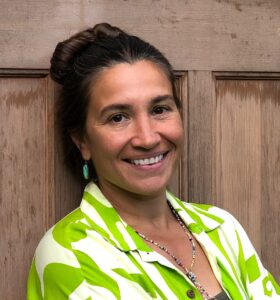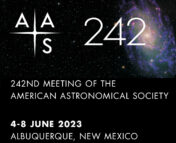In this series of posts, we sit down with a few of the keynote speakers of the 242nd AAS meeting to learn more about them and their research. You can see a full schedule of their talks here, and read our other interviews here!

Science questions as well as “how we actually do the science” and “the environment within which we do the science” are important to Kathryne Daniel, a professor and astronomer at the University of Arizona. As a plenary speaker at AAS242, she will delve into these ideas in her talk, “Two-Eyed Seeing”: Advancing the Field through Collective Dynamics, a title which recalls both her approach to studying collective emergent dynamics in galaxies and to science overall. The approach of seeing in two ways– with Indigenous knowledges in one eye and Western knowledges in the other–is powerful “in any situation where you are including multiple perspectives,” explains Dr. Daniel. Two-eyed seeing is “a phrase that is used in the Indigenous community, particularly around conversations that include both Western and Indigenous views.” This approach “adds depth perception” by creating “a sort of emergent understanding of any given thing.” Dr. Daniel describes emergent behavior as “a behavior where the convergence of two or more processes or situations combine to be more than the sum of its parts.” In her astrophysics research, this comes into play when studying galactic dynamics.
Galaxies have been evolving ever since they first formed hundreds of millions of years after the Big Bang. The evolution of a galaxy is often considered in the context of its external environment. While external factors are certainly important, internal processes– what happens within the galaxy itself– also play an important role. “There are many processes that lead to the evolution of galaxies through internal dynamics.” In her research, Dr. Daniel investigates questions such as “What is the nature of spiral structure? How does it impact the way galaxies evolve? Are there observational signatures of those particular processes?” in order to better understand how “the ecosystem of the Milky Way evolves itself” as well as the histories of other galaxies outside of our own. The two-eyed seeing approach adds depth to this research by bringing attention to how what is happening inside the galaxy influences its own evolution– the collective behavior of the system.
This depth of perception can also be applied to the research work environment. There is “a relationship between how the science is done and the place within which it is done” and “the place is inseparable from the people who consider [it] their home,” says Daniel. A self-described ‘infiltrator of academia with indigenous ways’, Dr. Daniel puts this principle into practice in her research, teaching, and while serving in roles such as member of the panel for the State of the Profession and Societal Impacts for the Astro2020 decadal survey (check out this astrobite) and as Deputy Director and Director of Land & Community Partnerships for the next-generation gravitational wave experiment, Cosmic Explorer. The latter role involves work on Cosmic Explorer’s Indigenous Partnership Program, which aims to re-conceptualize the typical western approach to facility design by involving local and Indigenous communities at all stages. “It’s a power-sharing model,” Daniel explains. In her plenary talk, she will discuss this program and also speak “to how this impacts us in the astronomy community in the sense of the connection between who we are as a community and the environment within which we do our work, and how that also affects scientific excellence.” Dr. Daniel notes that “our identities are not singularly as astronomers” and that bringing our full selves to our research leads to better science.
Path to Astronomy
Although always “in love with astronomy and astrophysics,” Dr. Daniel did not always expect to add her own perspective to the field of astronomy. Growing up in Houston, she had many friends with parents– specifically fathers– who were astronauts, yet it “never occurred to me that was something I could do,” she recollects. It wasn’t until her senior year of undergrad at Bryn Mawr College, an historically women’s college, that she realized astronomy might be for her. Following a degree in archaeology (which she is still very much in love with), she decided to consider the possibility of pursuing astrophysics after graduation. A year later she was back in school, studying for a bachelor’s degree in physics. After a year and a half, she had not only a physics degree but also research and some publications to boot. “It was a great experience,” she reflects.
She continued pursuing physics after this degree, but it was not a direct path to academia. After starting a family, the lack of support necessary for parenting while in graduate school at the time forced her to leave with a terminal masters. “I had no idea that I’d be coming back,” reflects Daniel. However, a few years later she reapplied to Johns Hopkins to complete a PhD in physics and astronomy. “They couldn’t keep me away,” she now laughs. For her this was a “wonderful lesson” in how there’s not a single correct path to follow. Rather, “life is this meandering set of pathways where we choose a direction and sometimes it converges back on the pathway we left, and sometimes it goes off in another direction and we get to keep making choices every single step of the way.” She advises to not just focus on what is immediately around you, “but to be open to all the opportunities that may come along” and “recognize that it’s never over, you get to keep making choices as you go along.”
Dr. Daniel’s path has now converged on an exciting career in astrophysics. Her research is what she’d “always hoped it would look like.” That is, in addition to compelling projects of her own, she has grown a group with “a collaborative environment where students are really taking the lead on projects” while she focuses on facilitating “direction and perspective in conversation.” These projects showcase the individual interests within the group and incorporate observations, research techniques, and simulations. Whatever the approach, the projects all center on emergent dynamics and “how galaxies [specifically spiral] evolved themselves.” While Dr. Daniel’s heart is in pen and paper calculations– “It’s cathartic,” she told me – and she likes the understanding which analytic theory provides, she also appreciates how the different methods work together to add to our overall understanding of galaxy evolution.
As an example, Dr. Daniel cites findings that have come from Gaia, a space observatory creating the largest and most precise 6D map of the Milky Way. “That survey really changed the way that we understand galactic dynamics. All of a sudden we were able to resolve the dis-equilibrium state of the Milky Way.” Prior to the observations, “we were really operating for the most part under the assumption of a smooth model for galaxy evolution,” although “there were hints the Milky Way might be otherwise.” The combination of developments in observations, simulations, and theory can be “a powerful method for disentangling the history of the Milky Way.”
Society of Indigenous Physicists
Not only is Dr. Daniel excited about where her field is going, but also about the research community forming in it. Just a few years ago, she co-founded the Society of Indigenous Physicists. “Our first meeting was in 2020– on Zoom,” Daniel told me. Since its inception, the society has grown from a handful of people to approximately fifty. “It’s really been a process of finding each other,” she explains. “Many of us thought that we were the only one, and couldn’t possibly believe it.” If you identify as Indigenous, Dr. Daniel would love to hear from you! And if you don’t identify as Indigenous, you can still check out the resources on the Society of Indigenous Physicists website to further educate yourself as an ally. Dr. Daniel looks forward to the society’s first in-person inaugural gathering, set to take place in the summer of 2024.
To hear more about collective dynamics in galaxies and research, tune into Dr. Daniel’s Plenary Lecture at 3:40 PM (MDT) on Wednesday, June 7 at #AAS242!
Edited by: Keighley Rockcliffe
Featured Image Credit: AAS

